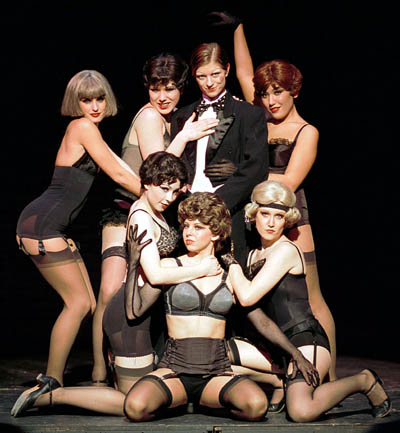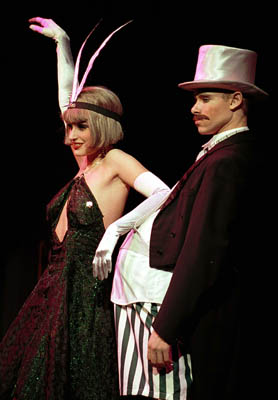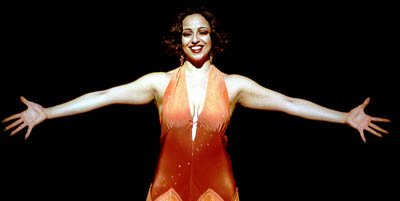Department of Theatre
presents
s

The
University of Minnesota Duluth
Department of Theatre
presents
s
Directed by Ann Aiko Bergeron
Scenic Design by Arden Weaver
Costume Design by Bill Brewer
Lighting Design by Mark Harvey
October 18-27, 2001
Lighting Design Approach
Without having talked previously, I was impressed by how much in sync the three designers and the director were at our initial meetings when we discussed how we wanted to present our production of Cabaret. One idea that emerged was an agreement to present the play with two distinct performances spaces, one surrounded by the other.
The smaller, cabaret stage would be at center utilizing the cabaret false proscenium. Color was a key element in the lighting design for the cabaret stage. Blues and magentas were used in early cabaret scenes to help create the atmosphere of excitement and fun.
The decision was made to make the decadence of Germany in the early 1930's as alluring to the audience as possible. This was accomplished with sexy, revealing costumes and a feeling of sophistication that suspended provincial mores.

In contrast to Cliff, the naive American journalist, Sally Bowles needed to be able to seduce and charm her way into his heart, and the hearts of the audience as well.
Side lighting was also important, particularly for the dance line numbers.
The Money Song was a turning point in the play. Represented with saturated green and red lighting, elements of greed and self-preservation at all costs began to creep into the entertaining atmosphere of the cabaret. The costumes helped support the song's satirical commentary on capitalism.

As the decadent slide of society continued, other garish colors were used in the design. In "Two Ladies", an intense yellow backlight was used to highlight wigs and costumes.
Surrounding the cabaret stage was an area that included the full thrust as well as the space between the stage and the audience seating area. While used initially to draw the audience into the action of the play, this space also came to represent the political stage of the influence of the Nazi party in 1929.
The song at the end of Act I spoke to the promise of a new dawn, yet felt particularly ominous because of the audience's knowledge of how history would unfold.
The beginning of Act II is the only scene in the play to bring the hope and promise of ordinary life and the garish escapism of the cabaret together. The wedding celebration begins festively, but ends with an anti-Semitic threat.
While the stage was often lit with garish, vibrant light to encouraged the audience to empathize with the need to escape the realities of the outside world, in other scenes the lighting was called upon to provide muted tones for realistic scenes such as Cliff's apartment and Fraulein Schneider's living room. These scenes brought an initial sense of hope and happiness, but eventually characters were confronted with the harsh realities of social policies based on hatred.
As we introduced the color red into the play, we visually underscored the ironies of life events that can somehow be both pleasurable and threatening.

In the Finale Ultimo, the play presents Sally Bowles, as well as the audience, with the choice that must be made between escaping social responsibility and risking personal comfort to preserve life and liberty. With Sally's enticing offer, even while the horror of World War II looms near, the audience feels the compelling urge to ignore all and join the life of the cabaret.
